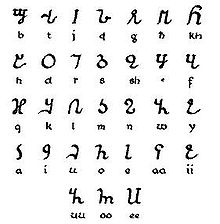In the Horn of Africa, several languages are widely spoken. From Amharic and Tigrinya in Ethiopia to Afar in Djibouti, many languages of the Cushitic branch of the Afro-Asiatic language family are spoken here. In Somalia, Somaliland and Djibouti, Somali has official language status in the former two, and national language status in the latter. Today, we see Somali written in the Latin alphabet, but what we do not usually see is the history behind the writing systems of Somali, from the traditional Arabic abjad to the Kaddare alphabet invented in 1952. This, like the writing systems for Igbo, calls for a deep dive in uncovering the writing systems in use, or formerly in use, for the Somali language.
Prior to the arrival of Europeans, the Somali language used the Arabic script, or a transliteration of Somali in the Arabic script, known as “Wadaad writing”, loosely translated to “religious man writing”. The Arabic script was introduced to Somalia in the 13th century, but it was not until centuries later, six whole centuries in fact, when the Arabic script was adapted to represent the sounds of Somali. This adapted script, unlike Arabic, had a total of 32 letters — 10 vowels, and 22 consonants. Many of these existing records could be found mainly in religious texts or scriptures, including Islamic poems called qasida, and recitations.
The turn of the 20th century brought the influence of the Latin alphabet brought in by the British and Italians into the Horn of Africa, challenging the status of the rather established use of the Arabic script in the Somali script. But this did not deter people from devising their own alphabets to represent Somali. The first of these examples is called the Osmanya script, or Far Soomaali (𐒍𐒖𐒇 𐒘𐒝𐒈𐒑𐒛𐒘) in Somali, and in Arabic, it is known as al-kitābah al-ʿuthmānīyah (الكتابة العثمانية; “Osman writing”).
Far Soomaali was invented in the early 1920s by the son of the Sultan Yusuf Ali Kenadid, the founder of the Sultanate of Hobyo, Osman Yusuf Kenadid. Unlike his brother Ali Yusuf Kenadid, who became the second Sultan of Hobyo, Osman was a Somali poet, writer, teacher, and ruler.
During the early 20th century, Somalis felt a strong sentiment to have a national script, but not really an Arab-ish one. This was part of the drive for Somali sovereignty. And so, sparked these attempts to create writing systems for Somali. Osman was one of these inventors involved. And along came a phonetically sophisticated alphabet called Osmanya. True to the movement, Osmanya bore no resemblance to the Latin and Arabic scripts, and here, came the challenger to the established Arabic script, and the newcomer Latin script, which were vying for dominance in the writing of the Somali language.
Osmanya was actually taught in local schools in the Hobyo Sultanate, which spoke a Banaadir dialect of Somali. While it gained a reasonably wide acceptance in Somalia, and actually had a sizable body of literature written with the script, there were huge challenges ahead for the writing system, and Osman himself.
First, came the Italians. The Italian colonial authorities caught wind of this spread of a new writing system for the Somali language, and deemed it a manifestation of nationalism. This resulted in Osman’s arrest by the Italians, and his imprisonment in Mogadishu, Somalia’s current capital city. With this, the efforts of making a standard orthography for the Somali language came to a grinding halt for the next 25 years. Died too, did the Osmanya writing system.

Putting the history of the writing system behind us, let us take a closer look at the Osmanya script. It is an alphabet, much like the Latin script, and written left to right. Once again, much like the Latin script. However, the individual names for the letters are, somewhat ironically, rather similar to Arabic, although it could be the case where Arabic and Somali are somewhat related languages. For example, the letter “q” is known as “qaaf”, and the letter “n” is known as “nuun”. In total, there are 30 letters in the alphabet, including 10 vowels and 20 consonants, largely representing most of the sounds of the Somali language, or at least that of the Banaadir varieties. Tone is not marked in Osmanya, however.
Despite the halt by the colonial authorities, the Osmanya script still made it into the Unicode in 2003, occupying the block U+10480–U+104AF.
So this has been a rather brief look into the Osmanya script, and also an introduction to the writing systems of the Somali language. In the next post in this series, we will look at two more prominent writing systems devised during this period in the early 20th century — Kaddare, and Borama.
This script is lovely and I love the design.
LikeLiked by 1 person